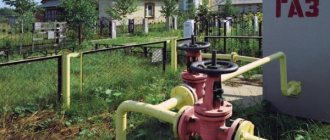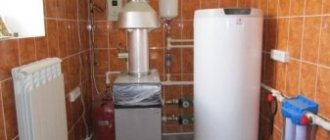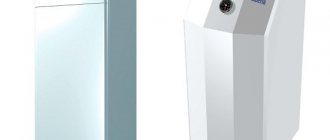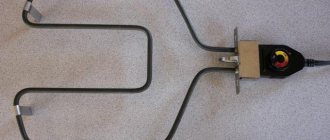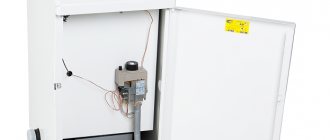Operating principle
A gas convector using bottled gas is a unit that functions similar to an electric convector. Since electric convectors are powered by electricity, which is highly expensive, gas appliances consume liquefied gas, which is a more economical “pleasure”. The result of the work is heat that spreads throughout the room.
The gas convector consists of the following parts:
- gas burner: it is located at the bottom of the metal chamber, gas is supplied to it, which burns and releases heat that enters the heat exchanger;
- heat exchanger: the main part of the device, it is in it that the air masses are heated;
- control system: it monitors the temperature and controls the gas supply;
- a chimney through which combustion products are discharged outside.
Some gas convectors are equipped with fans that create forced convection. Users respond extremely positively to such devices, because Such models heat the air in rooms much faster.
Calculation of power and gas consumption
Calculation of power and gas consumption depends on many parameters and factors related to both the characteristics of the device and environmental conditions.
Power
There is a special formula that allows you to calculate the average power of a gas convector. It looks like this: P = k*S, where:
- P – power;
- k – coefficient taking into account the type of system and operating conditions. Also called correction factor;
- S – area of the room.
The k value for balloon heating is taken as 0.1. If the only source of heat in the room is a gas convector, then this value is 0.12. In walk-through and infrequently visited premises, the coefficient is 0.15.
Advantages and disadvantages
A gas convector using bottled gas is a good heating equipment for any home and has many strengths:
- efficiency, since heating with natural or liquefied gas is inexpensive;
- work autonomy;
- safety.
But the operation of gas convectors, like any other device, has its drawbacks:
- equipment takes up a lot of space;
- to install the device, you need to make a hole in the wall for the chimney;
- noisy operation which may cause inconvenience.
Gas convectors Hosseven HDU series with steel heat exchanger
Equipment installation
To install powerful gas heating equipment, it is best to contact specialists, which will subsequently eliminate any problems in the operation of the equipment. Owners of dachas and small private houses who purchase and install convectors with a capacity of 2-4 kW of thermal energy can perform independent installation, which will allow them to save on contacting specialists.
For this work you will need the following tools:
- Plastic screws and dowels.
- Gas keys.
- Polyurethane foam.
- Screwdrivers.
- Hammer with crown and drill with drills.

First of all, you will need to decide on the installation location of the heating device. It is best to install it near the windows, which will simplify the installation of the chimney and coaxial pipe for removing combustion products.
The required holes are marked using a construction pencil and tape measure. It will be necessary to decide not only on the external location of the chimney and coaxial pipe, but also to plan the correct gas connection, especially when the cylinder is located on the street or in another room.
Holes are made in the walls using a drill with drill bits and a hammer drill with a diamond bit for concrete.
Using self-tapping screws, a liquefied gas converter is attached to the wall, pipes are laid out and all holes and cracks are filled with foam. Only after this can you begin to connect the gas cylinder to the heating equipment.
The cylinder is connected using special fittings that prevent leaks in connections and gas penetration into the room. If possible, all connections should be checked with a special tester , which detects even minimal gas leaks, which ensures complete safety of using heating equipment.
Features of operation
Gas-powered heaters differ in many ways. There is a huge variety of gas convectors on the heating equipment market, and if you decide to choose this option for heating your home, then be sure to pay attention to the following points:
- heat exchanger material;
- power;
- type of combustion chamber;
- energy carrier used;
- fan;
- type of convection;
- automatic control.
Let's consider each indicator separately.
- According to the installation method, there are models that are placed on the wall and on the floor. Wall-mounted ones are characterized by low weight and high efficiency, take up little space, but their maximum power reaches 10 kW. Floor-standing units weigh a lot, this is due to the fact that they are equipped with an enlarged heat exchanger; their productivity can reach several mW.
- The combustion chamber can be open or closed. Currently, units with a closed combustion chamber are more popular. In such convectors, a coaxial pipe is used instead of a chimney. Such devices remove combustion products to the street and from there the process of taking air for the operation of the burner is carried out. Gas convectors with a closed combustion chamber have only one obvious drawback - high cost. Compared to classic models, their price is 40-50% higher. To operate convectors with an open combustion chamber, you need a traditional chimney that will go up. In addition, it is necessary to ensure the flow of oxygen into the room - this is done through an vent that connects to the outside atmosphere or through open vents.
- The heat exchanger material is an important factor when choosing a gas convector. Heat exchangers are made of steel and cast iron. If you want the heating device to function successfully for many years, then purchase models with a cast iron heat exchanger. They are not cheap, but with proper use they can last 40-50 years. If you want to save money, then pay attention to devices with a steel heat exchanger; such units are inexpensive, but their durability is no different, and steel is susceptible to rust. Experts advise purchasing cast iron heat exchangers.
- Gas convectors can operate as natural and forced convection. Units operating on the principle of natural convection practically do not produce any sounds and do not cause discomfort to the ear. However, the rate of heating of rooms by such devices is low, and this causes inconvenience at the initial start-up stage. Gas convectors with forced convection are more efficient. They, like units with natural draft, operate from bottled gas, but are equipped with additional fans that force air through the heat exchanger. As a result, the room warms up quickly. But at the same time, they make noise.
- Automatic control. More budget options are equipped with conventional thermostats. Thanks to the programmable control unit, you can control the room temperature and select the desired heating mode.
- When choosing the power of a gas convector, you need to consider the following: for every 10 m² of area you need 1 kW of thermal energy.
It is recommended to choose convectors with a power reserve of 10-15%.
Improving the heat exchanger of the alpine air ngs50 gas convector
Want to create a site? Find Free WordPress Themes and plugins.
We improve the heat exchanger of the alpine air ngs50 gas convector (we will not let the heat escape into the chimney)
Hello everyone! I want to write a story about improving the efficiency of a gas convector with a cast iron heat exchanger alpine air n50.gs
They delivered me a new frame house of 70 m2 in the fall. I had a question about heating - at first I wanted a stove, but I heard from a friend about such a miracle as a gas convector using bottled gas - he had already purchased such a heater for himself and praised it very much - they say heating a house costs less money even than using wood... A friend’s house is brick - and I have a wooden frame - at first I was afraid to install this gas convector for heating in a wooden house - but winter is just around the corner - and light is expensive these days, so I decided to buy it.
First I tried to look for a gas convector in Leroy Merlin (fortunately, I have a store 500 meters from my house) - unfortunately they weren’t there. Then I decided to purchase it online.
There were a lot of offers, but I decided to buy an alpine air ngs 50 gas convector with a cast iron closed combustion chamber - cost 18,500 rubles (November 2015) + propane cylinder 1,850 rubles
Alpina gas convector has arrived. Here's a photo of what it looks like from the outside:
gas convector alpine 50
Alpine gas convector for heating the house
Please note that the convector is initially equipped with nozzles for natural gas.
To use propane, the nozzles need to be changed (they come in a set of 2 pieces)
Replacing nozzles with bottled propane gas - on an alpine air convector - and installing a gas convector.
- remove the white protective cover.
- We see three thin tubes on the cast iron under a glass circle in front - we need the middle one - aluminum - we unscrew it - the first nozzle is under it - we change it.
- On the right side of the cast iron we see a thick aluminum tube - unscrew it - on the cast iron - where this tube was screwed in there remains a large 19 nut - we also unscrew it - under it there is a second nozzle.
- the convector is ready to work with bottled propane
I filled a 50 liter cylinder with gas, drilled one 180 hole in the wall of the house for the chimney from the convector, and one small one for the gas hose.
Since my house is made of wood, I covered the wall behind the convector with galvanization and wrapped the chimney pipe well with fiberglass.
Starting the gas convector turned out to be very simple - we set the cylinder reducer to the minimum pressure - then on the convector we turn the knob to the ignition position - press it - you can hear the gas starting to flow - and press the piezo ignition button. That's it - the wick lights up - turn the knob to the desired temperature position - for example 4. - through the glass window you can see how the main burner lights up.
So this convector worked in my house for a little more than a week - the 50 liter propane cylinder did not run out; the gas convector on bottled gas gas consumption turned out to be enough for 8-9 days for one cylinder - the price of refilling is 800 rubles.
My House is two floors, 74 m2, there are no other heaters - the temperature outside was from -3 at night to +4 during the day. in two days of work - it completely warmed up my house - on the first floor 10-12 degrees, on the second about 9-10 degrees. For one such a small battery I think it’s quite good!!!
———————————————————————————————————————-
BUT 8 days later, I still removed the convector; I was not given any peace by the fact that my money was going down the drain - and this in the literal sense.
The fact is that despite the statements of the manufacturers of this alpine air ngs50 gas convector that its efficiency is 89%, if you go up to the chimney pipe and put your hand on it, you will understand that this is, to put it mildly, not true - you cannot hold your hand for more than 5 seconds perhaps even with only one wick working - IN OTHER WORDS - my warmth - everything flew out into the street - And I could not come to grips with such injustice.
The Gas Convector has been dismantled. Took it to the garage and disassembled it.
I decided to modify the gas convector by installing a copper heat exchanger in the chimney.
Improvements to cast iron fins - by welding additional cooling fins and installing a fan for airflow.
So: - first things first - and let’s start with a photo of the convector in disassembled form:
Alpine gas convector without casing
closed combustion chamber of a gas convector
rear view - chimney pipe
convector alpine
For the heat exchanger, I purchased on the market a copper tube with a diameter of 12 mm -2.5 meters at 300 rubles per meter - and 15 mm 1.5 meters at 350 rubles per meter, plus a couple of 15 corners at 90 degrees.
Further in the photo you will see that the chimney pipe consists of two pipes - (or rather even 4 since they are telescopic) the inner one - on which a copper tube is wound in the photo above and the outer one - (it has been removed.)
The initial idea was to simply wind a spiral of 12 copper tubes onto the inner chimney pipe - but then I realized that this would give me little effect - and it was decided to insert the heat exchanger inside the pipe.
Argon welding machine Pro TIG 200P AC/DC settings for copper soldering welding
You can’t buy a heat exchanger of such length and diameter anywhere. We will cook the copper ourselves with argon.
copper tube blanks for heat exchanger
We cut the copper tube with a grinder at 45 degrees and solder it with argon
we got these two copper diamonds
I solder 4 12mm copper tubes to these diamonds
We drill holes with a 10 drill bit and process them with a roller cutter.
I welded two tubes with argon - there are two more left
This thing will prevent heat from escaping into the street - and will return it back to the house!!!
gas convector pipe with heat exchanger
I apologize that I wasn’t able to take pictures of all the stages, but I think the main thing is to understand the principle...
And the principle here is that we built a copper samovar into a pipe - let water flow through the pipes and hang a small radiator in the house. And the precious heat will no longer fly out of the house - but will be used for its intended purpose - to heat the room inside, and not the street outside.
Connected the battery to the gas convector
Hurray, finally got around to it. The system was finally assembled and launched:
I installed a gas convector to the heat exchanger, connected polypropylene pipes - d20mm - on the second floor I bought a small battery for 6 sections from Leroy for 1600 rubles:
(later, heating practice in winter showed that 6 sections of the battery were not enough; it was replaced by 10 sections)
heating from convector
I made the heating system without an expansion tank and without any pumps - everything will flow by gravity - only one drain valve from below - through which we pumped the coolant in with a baby pump.
Now about the most interesting thing: My review of how the Alpine gas convector with a heat exchanger built into the exhaust pipe now works.
I set the Adjustment knob on the converter to 4 - this is about 13 degrees indoors. In this mode, my burner almost didn’t turn on - only one wick was burning - now if you put your hand on the exhaust pipe on the street, you can hardly feel the heat - of course - it now goes into the radiator on the second floor. The battery in this mode heats up slightly -30 degrees approximately to the touch.
The most interesting thing is when the adjustment on the gas converter is 6-
then the burner lights up at full power - in this mode, previously it was impossible to hold your hand on the exhaust for more than 2 seconds - now, of course, it feels like we have recycled (returned to the house) most of the heat that was previously thrown out into the street.
After an hour of operation in this mode, the battery on the second floor warms up well - it feels like about 50 degrees - now it became clear that the system works perfectly - the only thing I regretted was that I bought a battery for only 6 sections - I should have bought 10 or 12.
And the heat exchanger - it could be better - not 4 but 6 or even 8 copper tubes, or it would be better to make fins.
But I’ll finish this revision for now - I was interested in the principle itself - to return the heat of the convector exhaust back into the house. My idea worked and I am very, very happy about it...
If this article of mine has benefited you, help me too - just go once to my second site:
WELDER - DMITROV, RF
There will be a continuation of the article on improving Alpine gas convectors.
Did you find apk for android? You can find new Free Android Games and apps.
Power calculation
Let us give a calculation of the convector power for rooms with a ceiling height of up to 3 meters.
| Room area, m² | Convector power for thermally insulated and heated premises, W | Convector power for thermally insulated but unheated rooms, W |
| 10 | 1000 | 1000-1250 |
| 15 | 1250 | 1500-2000 |
| 20 | 1750 | 2000-2500 |
| 25 | 2000 | 2500 or 2 pieces for 1500 |
| 30 | 2400 | 2 pieces for 1500 (2000) |
| 35 | 2 pieces for 1500 | 2 pieces for 1750 (2500) |
Choice
When choosing a convector using bottled gas, first look at the technical characteristics of the heaters. As already noted, the best option is a device with a cast iron heat exchanger and a programmable control unit.
However, if you decide to purchase such a unit, be sure to take into account such indicators as:
- Power calculation. Since air convection occurs when heating a room, such heaters are effective only in a limited space; for each individual room, you will need to install a separate convector.
- Housing type. Units equipped with a closed combustion chamber and a coaxial chimney are ideal for apartments; in a private house, absolutely any type of device can be installed.
- Type of fuel. A gas convector that runs on liquefied gas is not allowed to be installed in an apartment in a multi-storey building. This is due to the high explosion hazard of the cylinders.
A gas convector consumes 90 grams of propane per 1 kW of power.
All convectors are initially manufactured taking into account the possibility of connecting to the main gas pipeline. If you want to connect the device to the cylinder, then you need to ensure that you have a special reducer.
Choose a convector based on the area of the room and your financial capabilities. You should not buy a unit with high power for a small room. This will do nothing but overheat the air and excessive gas consumption.
You can read about the operation of a natural gas convector here.
Heat exchangers for water convectors
Heat exchangers of water convectors are made of the following metals:
- Steel (plain, galvanized and stainless);
- Copper;
- Copper and aluminum.
The design of the heat exchanger consists of a pipe with a diameter of 12 - 20 mm, equipped at the ends with ½ or ¾ inch threads and bent in a U-shape. There can be from one to several loops in the heat exchanger (single-pipe and multi-pipe devices). Convective fins are applied to the outer surface of the pipe. Depending on the material of manufacture, the plates (lamellas) are attached to the pipe in the following ways:
- Steel – using welding;
- Copper - soldering;
- Aluminum to copper - mandrel (plates are placed on a pipe, then the pipe under the plate is expanded, creating a tight fit).
The plates are fixed to the pipe with a calculated pitch (the distance between the individual plates). It is calculated taking into account the achievement of the maximum value of the heat transfer area and the minimum resistance to convective air flow.
The plates can have not only a smooth, but also a corrugated (corrugated, wavy) surface - the heat transfer surface area increases and the operating efficiency of the device increases. There are models of convectors with wire-type fins for heat exchangers - they use twisted wire mesh. Such devices are more effective, but are expensive, which is why they are not widely used.
The most effective are heat exchangers made of copper (pipe and lamellas), they are slightly inferior to products made of copper (pipe) and aluminum (plates). Both types of heat exchangers are universal in terms of coolant and can be installed in centralized and autonomous water heating systems. The average operating parameters of the devices have the following values:
- Working pressure – from 12 to 15 atm.;
- Test pressure in production – up to 25 atm;
- Coolant temperature: 110 – 1300C.
Convectors can have 1 or 2 heat exchangers - the air is heated sequentially. There are also models with 2 heat exchangers, one of which can work for heating air, the other for cooling. The heat exchanger of almost all convectors is easily removable - for easy cleaning of the device from dust.
Steel heat exchangers are less efficient than products made of non-ferrous metals. They are inferior to them in terms of heat transfer and are susceptible to the negative effects of corrosion. It is recommended to install heating devices with steel heat exchangers only in closed, autonomous water heating systems - with a low air content and an almost constant chemical composition of the coolant. Devices made of high-alloy steel are rare - they do not rust, but are quite expensive.






